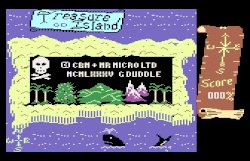| Treasure Island | |
|---|---|
 Plus/4 title screen | |
| Publisher | Mr. Micro |
| Platforms | ZX Spectrum, Commodore 64, Plus/4, C16 |
| Release | 1984 |
| Genre | Action-adventure |
| Mode | Single-player |
Treasure Island is a 1984 computer game based on the 1883 novel Treasure Island by Robert Louis Stevenson. In the game, the player takes on the role of the book's protagonist Jim Hawkins and has to battle through hordes of pirates before a final showdown with Long John Silver. The game uses a flip-screen style.
Contents
The programming was done by Greg Duddle, and the music was rendered by David Whittaker. [1] The version for the Commodore 64 and ZX Spectrum was released in 1984, and the Plus/4 version was from 1985. The latter version is bug free and has minor differences. On the Commodore 64 and ZX Spectrum it is impossible to get the maximum score because of bugs. The Commodore Plus/4 version was also converted for the Corvette in 1989.
